 W
WAerinite (Ca4(Al,Fe,Mg)10Si12O35(OH)12CO3·12H2O) is a bluish-purple inosilicate mineral. It crystallizes in the monoclinic system and occurs as fibrous masses and coatings. It has a dark, vitreous luster, a specific gravity of 2.48 and a Mohs hardness of 3.
 W
WAeschynite-(Y) (or Aeschinite-(Y), Aeschynite-(Yt), Blomstrandine, Priorite) is a rare earth mineral of yttrium, calcium, iron, thorium, titanium, niobium, oxygen, and hydrogen with formula: (Y,Ca,Fe,Th)(Ti,Nb)2(O,OH)6. Its name comes from the Greek word for "shame". Its Mohs scale rating is 5 to 6.
 W
WAnthophyllite is an amphibole mineral: ☐Mg2Mg5Si8O22(OH)2 (☐ is for a vacancy, a point defect in the crystal structure), magnesium iron inosilicate hydroxide. Anthophyllite is polymorphic with cummingtonite. Some forms of anthophyllite are lamellar or fibrous and are classed as asbestos. The name is derived from the Latin word anthophyllum, meaning clove, an allusion to the most common color of the mineral.
 W
WArsenopyrite is an iron arsenic sulfide (FeAsS). It is a hard metallic, opaque, steel grey to silver white mineral with a relatively high specific gravity of 6.1. When dissolved in nitric acid, it releases elemental sulfur. When arsenopyrite is heated, it produces poisonous sulfur and arsenic fumes which can be fatal if inhaled in large quantities. With 46% arsenic content, arsenopyrite, along with orpiment, is a principal ore of arsenic. When deposits of arsenopyrite become exposed to the atmosphere, the mineral will slowly oxidize, converting the arsenopyrite into an iron arsenate, a relatively stable compound. Arsenopyrite is generally an acid consuming sulfide mineral unlike iron pyrite which can lead to acid mine drainage.
 W
WAugite is a common rock-forming pyroxene mineral with formula (Ca,Na)(Mg,Fe,Al,Ti)(Si,Al)2O6. The crystals are monoclinic and prismatic. Augite has two prominent cleavages, meeting at angles near 90 degrees.
 W
WBeudandite is a secondary mineral occurring in the oxidized zones of polymetallic deposits. It is a lead, iron, arsenate, sulfate with endmember formula: PbFe3(OH)6SO4AsO4.
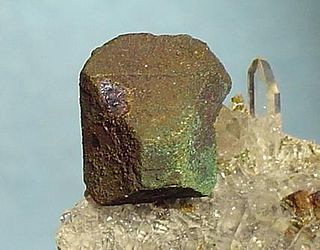 W
WBornite, also known as peacock ore, is a sulfide mineral with chemical composition Cu5FeS4 that crystallizes in the orthorhombic system (pseudo-cubic).
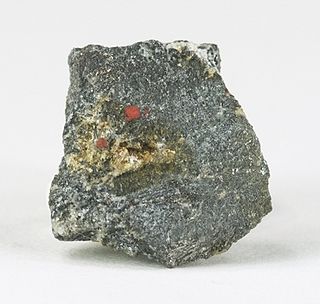 W
WBukovite is a rare selenide mineral with formula Tl2Cu3FeSe4. It is a brown to black metallic mineral which crystallizes in the tetragonal system.
 W
WCerite is a complex silicate mineral group containing cerium, formula (Ce,La,Ca)9(Mg,Fe3+)(SiO4)6(SiO3OH)(OH)3. The cerium and lanthanum content varies with the Ce rich species and the La rich species. Analysis of a sample from the Mountain Pass carbonatite gave 35.05% Ce2O3 and 30.04% La2O3.
 W
WChalcopyrite ( KAL-ko-PY-ryt) is a copper iron sulfide mineral that crystallizes in the tetragonal system. It has the chemical formula CuFeS2. It has a brassy to golden yellow color and a hardness of 3.5 to 4 on the Mohs scale. Its streak is diagnostic as green tinged black.
 W
WChapmanite is a rare silicate mineral belonging to the nesosilicate group, discovered in 1924, and named in honour of the late Edward John Chapman (1821–1904), a geology professor at the University of Toronto. Chemically, it is an iron antimony silicate, closely related to bismutoferrite, and may contain aluminium impurities. It is closely associated with silver mines, most notably the Keeley mine in Ontario, Canada, found in quartz veinlets containing graphite in gneiss. It takes the form of a powdery, yellow-green, semitransparent solid, and leaves a streak of the same color. Early German texts have referred to the mineral as antimon-hypochlorite.
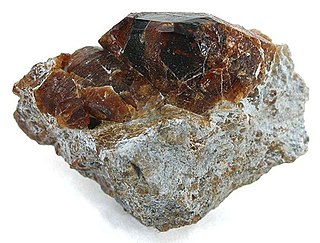 W
WChondrodite is a nesosilicate mineral with formula (Mg,Fe)5(SiO4)2(F,OH,O)2. Although it is a fairly rare mineral, it is the most frequently encountered member of the humite group of minerals. It is formed in hydrothermal deposits from locally metamorphosed dolomite. It is also found associated with skarn and serpentinite. It was discovered in 1817 on Mt. Somma, part of the Vesuvius complex in Italy, and named from the Greek for "granule", which is a common habit for this mineral.
 W
WCobaltite is a sulfide mineral composed of cobalt, arsenic, and sulfur, CoAsS. Its impurities may contain up to 10% iron and variable amounts of nickel. Structurally, it resembles pyrite (FeS2) with one of the sulfur atoms replaced by an arsenic atom.
 W
WCohenite is a naturally occurring iron carbide mineral with the chemical structure (Fe, Ni, Co)3C. This forms a hard, shiny, silver mineral which was named by E. Weinschenk in 1889 after the German mineralogist Emil Cohen, who first described and analysed material from the Magura meteorite found near Slanica, Žilina Region, Slovakia. Cohenite is found in rod-like crystals in iron meteorites.
 W
WCorkite is a phosphate mineral in the beudantite subgroup of the alunite group. Corkite is the phosphate analogue of beudantite and with it, a complete solid solution range exists. Corkite will also form a solid solution with kintoreite.
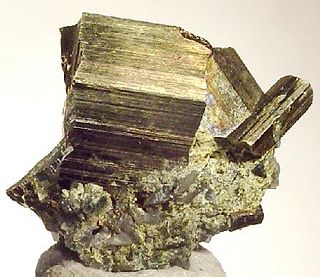 W
WCubanite is a yellow mineral of copper, iron, and sulfur, CuFe2S3.
 W
WCylindrite is a sulfosalt mineral containing tin, lead, antimony and iron with formula: Pb3Sn4FeSb2S14. It forms triclinic pinacoidal crystals which often occur as tubes or cylinders which are in fact rolled sheets. It has a black to lead grey metallic colour with a Mohs hardness of 2 to 3 and a specific gravity of 5.4.
 W
WDallol is a unique, terrestrial hydrothermal system in Ethiopia. It is known for its unearthly colors and mineral patterns, and the very acidic fluids that discharge from its hydrothermal springs.
 W
WEmery, or corundite, is a dark granular rock used to make abrasive powder. It largely consists of corundum, mixed with other minerals such as the iron-bearing spinels, hercynite, and magnetite, and also rutile (titania). Industrial emery may contain a variety of other minerals and synthetic compounds such as magnesia, mullite, and silica.
 W
WEudialyte, whose name derives from the Greek phrase Εὖ διάλυτος eu dialytos, meaning "well decomposable", is a somewhat rare, nine member ring cyclosilicate mineral, which forms in alkaline igneous rocks, such as nepheline syenites. Its name alludes to its ready solubility in acid.
 W
WFayalite (Fe2SiO4; commonly abbreviated to Fa) is the iron-rich end-member of the olivine solid-solution series. In common with all minerals in the olivine group, fayalite crystallizes in the orthorhombic system (space group Pbnm) with cell parameters a 4.82 Å, b 10.48 Å and c 6.09 Å.
 W
WFerrokentbrooksite is a moderately rare mineral of the eudialyte group, with formula Na15Ca6(Fe,Mn)3Zr3NbSi25O73(O,OH,H2O)3(Cl,F,OH)2. The original formula was extended form to show the presence of cyclic silicate groups and presence of silicon at the M4 site, according to the nomenclature of eudialyte group. As suggested by its name, it is the (ferrous) iron analogue of kentbrooksite. When compared to the latter, it is also chlorine-dominant instead of being fluorine-dominant. The original (holotype) material is also relatively enriched in rare earth elements, including cerium and yttrium.
 W
WFerronickel platinum is a very rarely occurring minerals from the mineral class of elements (including natural alloys, intermetallic compounds, carbides, nitrides, phosphides and silicides) with the chemical composition Pt2FeNi and thus is chemically seen as a natural alloy, more precisely an intermetallic compound of platinum, nickel and iron in a ratio of 2:1:1.
 W
WOrthorhombic ferroselite and its isometric polymorph dzharkenite are iron selenides of general formula FeSe2 precipitated under reducing conditions in anoxic environments. They are a source of selenium in the Rocky Mountains where selenium occurrence is associated with Upper Cretaceous shale deposits.
 W
WFreibergite is a complex sulfosalt mineral of silver, copper, iron, antimony and arsenic with formula (Ag,Cu,Fe)12(Sb,As)4S13. It has cubic crystals and is formed in hydrothermal deposits. It forms one solid solution series with tetrahedrite and another with argentotennantite. Freibergite is an opaque, metallic steel grey to black and leaves a reddish-black streak. It has a Mohs hardness of 3.5 to 4.0 and a specific gravity of 4.85 - 5. It is typically massive to granular in habit with no cleavage and an irregular fracture.
 W
WGermanite is a rare copper iron germanium sulfide mineral, Cu26Fe4Ge4S32. It was first discovered in 1922, and named for its germanium content. It is only a minor source of this important semiconductor element, which is mainly derived from the processing of the zinc sulfide mineral sphalerite. Germanite contains gallium, zinc, molybdenum, arsenic, and vanadium as impurities.
 W
WGlaucodot is a cobalt iron arsenic sulfide mineral with formula (Co,Fe)AsS. The cobalt:iron(II) ratio is typically 3:1 with minor nickel substituting. It forms a series with arsenopyrite (FeAsS). It is an opaque grey to tin-white typically found as massive forms without external crystal form. It crystallizes in the orthorhombic system. The locality at Håkansboda, Sweden has rare twinned dipyramidal crystals. It is brittle with a Mohs hardness of 5 and a specific gravity of 5.95. It occurs in high temperature hydrothermal deposits with pyrrhotite and chalcopyrite. Glaucodot is classed as a sulfide in the arsenopyrite löllingite group.
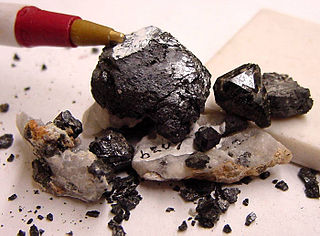 W
WHercynite is a spinel mineral with the formula FeAl2O4.
 W
WHornblende is a complex inosilicate series of minerals. It is not a recognized mineral in its own right, but the name is used as a general or field term, to refer to a dark amphibole.
 W
WIcosahedrite is the first known naturally occurring quasicrystal phase. It has the composition Al63Cu24Fe13 and is a mineral approved by the International Mineralogical Association in 2010. Its discovery followed a 10-year-long systematic search by an international team of scientists led by Luca Bindi and Paul J. Steinhardt to find the first natural quasicrystal.
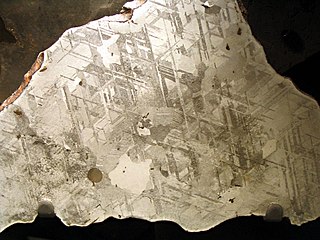 W
WKamacite is an alloy of iron and nickel, which is found on Earth only in meteorites. The proportion iron:nickel is between 90:10 and 95:5; small quantities of other elements, such as cobalt or carbon may also be present. The mineral has a metallic luster, is gray and has no clear cleavage although its crystal structure is isometric-hexoctahedral. Its density is about 8 g/cm3 and its hardness is 4 on the Mohs scale. It is also sometimes called balkeneisen.
 W
WKhomyakovite is an exceedingly rare mineral of the eudialyte group, with formula Na12Sr3Ca6Fe3Zr3WSi(Si9O27)2(Si3O9)2O(O,OH,H2O)3(OH,Cl)2. The original formula was extended to show the presence of both the cyclic silicate groups and M4-site silicon, according to the nomenclature of the eudialyte group. Some niobium substitutes for tungsten in khomyakovite. Khomyakovite is an iron-analogue of manganokhomyakovite, the second mineral being a bit more common. The two minerals are the only group representatives, beside taseqite, with species-defining strontium, although many other members display strontium diadochy. Khomyakovite is the third eudialyte-group mineral with essential tungsten (after johnsenite-(Ce) and manganokhomyakovite).
 W
WLoellingite, also spelled löllingite, is an iron arsenide mineral with formula FeAs2. It is often found associated with arsenopyrite (FeAsS) from which it is hard to distinguish. Cobalt, nickel and sulfur substitute in the structure. The orthorhombic lollingite group includes the nickel iron arsenide rammelsbergite and the cobalt iron arsenide safflorite. Leucopyrite is an old synonym for loellingite.
 W
WMalhmoodite is a phosphate mineral first discovered at a mine called Union Carbide in Wilson Springs, Arkansas, United States. This mine is 10 km west of Magnet Cove, an alkaline igneous complex, and Union Carbide is in a contact region of alkalic igneous rocks and surrounding sedimentary rocks. The mineral has been approved by the Commission on New Minerals and Mineral Names, IMA, to be named for the late Bertha K. Malhmood, the Administrative Assistant of the Branch of Analytical Laboratories, U.S. Geological Survey.
 W
WOsumilite is a very rare potassium-sodium-iron-magnesium-aluminium silicate mineral. Osumilite is part of the milarite group of cyclosilicates.
 W
WPentlandite is an iron–nickel sulfide, (Fe,Ni)9S8. Pentlandite has a narrow variation range in Ni:Fe but it is usually described as having a Ni:Fe of 1:1. It also contains minor cobalt, usually at low levels as a fraction of weight.
 W
WPyrrhotite is an iron sulfide mineral with the formula Fe(1-x)S. It is a nonstoichiometric variant of FeS, the mineral known as troilite. Pyrrhotite is also called magnetic pyrite, because the color is similar to pyrite and it is weakly magnetic. The magnetism decreases as the iron content increases, and troilite is non-magnetic.
 W
WRaslakite is a rare mineral of the eudialyte group with the formula Na15Ca3Fe3(Na,Zr)3Zr3(Si,Nb)SiO(Si9O27)2(Si3O9)2(OH,H2O)3(Cl,OH). This formula is based on the original one, and is extended to show the presence of cyclic silicate groups. The additional silicon and oxygen shown in separation from the cyclic groups (in parentheses) are in fact connected with two 9-fold rings. The mineral has lowered symmetry (space group R3, instead of more specific for the group R3m one), similarly to some other eudialyte-group members: aqualite, labyrinthite, oneillite and voronkovite. The specific feature of raslakite is, among others, the presence of sodium and zirconium at the M2 site. Raslakite was named after Raslak Cirques located nearby the type locality.
 W
WRastsveatevite is a rare mineral of the eudialyte group with the formula Na27K8Ca12Fe3Zr6Si4[Si3O9]4[Si9O27]4(O,OH,H2O)6Cl2. Its structure is modular. It is only the third member of the group after andrianovite and davinciite with essential (site-dominating) potassium. Potassium and sodium enter both N4 and M2 sites. The mineral is named after Russian crystallographer Ramiza K. Rastsvetaeva.
 W
WRingwoodite is a high-pressure phase of Mg2SiO4 (magnesium silicate) formed at high temperatures and pressures of the Earth's mantle between 525 and 660 km (326 and 410 mi) depth. It may also contain iron and hydrogen. It is polymorphous with the olivine phase forsterite (a magnesium iron silicate).
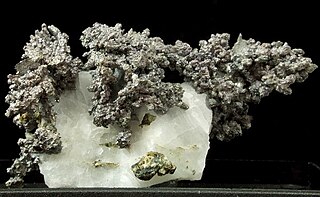 W
WSafflorite is a rare cobalt iron arsenide mineral with formula: (Co,Fe)As2. Pure safflorite would be just CoAs2, but iron is virtually always present. Safflorite is a member of the three-way substitution series of arsenides known as the loellingite or loellingite group. More than fifty percent iron makes the mineral loellingite whereas more than fifty percent nickel and the mineral is rammelsbergite. A parallel series of antimonide minerals exist.
 W
WSamarskite is a radioactive rare earth mineral series which includes samarskite-(Y) with formula: (YFe3+Fe2+U,Th,Ca)2(Nb,Ta)2O8 and samarskite-(Yb) with formula (YbFe3+)2(Nb,Ta)2O8. The formula for samarskite-(Y) is also given as: (Y,Fe3+,U)(Nb,Ta)O4.
 W
WSaponite is a trioctahedral mineral of the smectite group. Its chemical formula is Ca0.25(Mg,Fe)3((Si,Al)4O10)(OH)2·n(H2O). It is soluble in sulfuric acid. It was first described in 1840 by Svanberg. Varieties of saponite are griffithite, bowlingite and sobotkite.
 W
WSchreibersite is generally a rare iron nickel phosphide mineral, (Fe,Ni)3P, though common in iron-nickel meteorites. The only known occurrence of the mineral on Earth is located on Disko Island in Greenland.
 W
WSmaltite is a variety of the mineral skutterudite consisting of cobalt iron nickel arsenide: (Co,Fe,Ni)As2.
 W
WStannite is a mineral, a sulfide of copper, iron, and tin.
 W
WSugilite ( SOO-gi-lyt) is a relatively rare pink to purple cyclosilicate mineral with the complex chemical formula KNa2(Fe, Mn, Al)2Li3Si12O30. Sugilite crystallizes in the hexagonal system with prismatic crystals. The crystals are rarely found and the form is usually massive. It has a Mohs hardness of 5.5 to 6.5 and a specific gravity of 2.75 to 2.80. It is mostly translucent.
 W
WSzomolnokite (Fe2+SO4·H2O) is a monoclinic iron sulfate mineral forming a complete solid solution with magnesium end-member kieserite (MgSO4·H2O). In 1877 szomolnokite’s name was derived by Joseph Krenner from its type locality of oxidized sulfide ore containing iron in Szomolnok, Slovakia (Hungary at the time).
 W
WTaenite (Fe,Ni) is a mineral found naturally on Earth mostly in iron meteorites. It is an alloy of iron and nickel, with nickel proportions of 20% up to 65%.
 W
WTalnakhite is a mineral of chalcopyrite group with formula: Cu9(Fe, Ni)8S16. It was named after the Talnakh ore deposit, near Norilsk in Western Siberia, Russia where it was discovered as reported in 1963 by I. Budko and E. Kulagov. It was officially named "talnakhite" in 1968. Despite the initial announcement it turned out to be not a face centered high-temperature polymorph of chalcopyrite, but to have composition Cu18(Fe, Ni)18S32. At 80 °C (176 °F) to 100 °C (212 °F) it decomposes to tetragonal cubanite plus bornite.
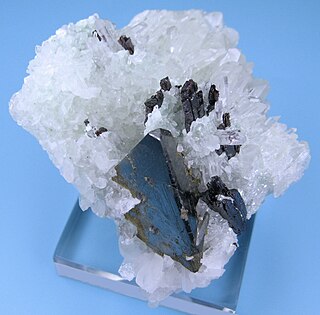 W
WTetrahedrite is a copper antimony sulfosalt mineral with formula: (Cu,Fe)12Sb4S13. It is the antimony endmember of the continuous solid solution series with arsenic-bearing tennantite. Pure endmembers of the series are seldom if ever seen in nature. Of the two, the antimony rich phase is more common. Other elements also substitute in the structure, most notably iron and zinc, along with less common silver, mercury and lead. Bismuth also substitutes for the antimony site and bismuthian tetrahedrite or annivite is a recognized variety. The related, silver dominant, mineral species freibergite, although rare, is notable in that it can contain up to 18% silver.
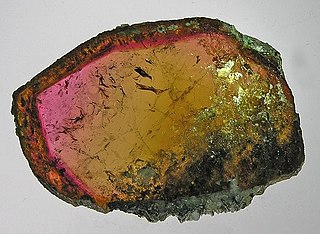 W
WTourmaline is a crystalline boron silicate mineral compounded with elements such as aluminium, iron, magnesium, sodium, lithium, or potassium. Tourmaline is classified as a semi-precious stone. This gemstone can be found in a wide variety of colors.
 W
WUmber is a natural brown or reddish-brown earth pigment that contains iron oxide and manganese oxide. Umber is darker than the other similar earth pigments, ochre and sienna.
 W
WVillamanínite is a copper sulfide mineral with small amounts of other elements, belonging to group II according to the Strunz classification. It was discovered in 1920 when studying the copper minerals of the Providencia mine in the municipality of Cármenes, León (Spain). The English researchers who identified it gave it the name of villamaninite when they confused the municipality in which the mine was actually located, because Villamanín is where the ore was loaded onto the railroad for export.
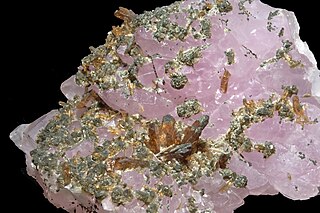 W
WZanazziite is a complex hydrated phosphate mineral from the roscherite group. It is a magnesium beryllium phosphate mineral. Zanazziite arises as barrel-shaped crystals and can reach up to 4 mm. It grows alongside quartz minerals. It is found in the crevices of Lavra da Ilha pegmatite, near Taquaral, in northeastern Minas Gerais, Brazil. Zanazziite is named after Pier F. Zanazzi. Zanazziite has an ideal chemical formula of Ca2Mg5Be4(PO4)6(OH)4·6H2O.
 W
W W
W W
W